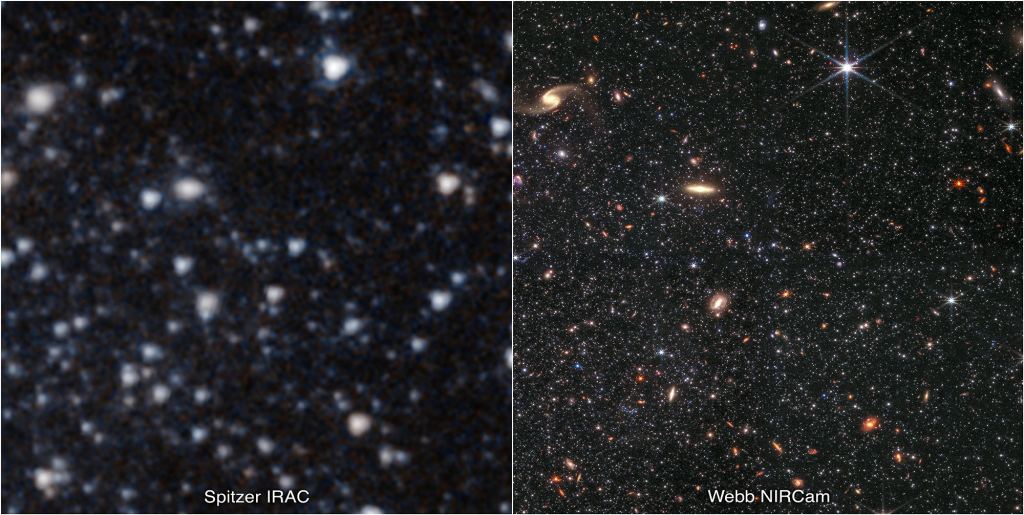The James Webb Space Telescope Early Release Science (ERS) program – first released on July 12th, 2022 – has proven to be a treasure trove of scientific finds and breakthroughs. Among the many areas of research it is enabling, there’s the study of Resolved Stellar Populations (RSTs), which was the subject of ERS 1334. This refers to large groups of stars close enough that individual stars can be discerned but far enough apart that telescopes can capture many of them at once. A good example is the Wolf-Lundmark-Melotte (WLM) dwarf galaxy that neighbors the Milky Way.
Kristen McQuinn, an assistant professor of astrophysics at Rutgers University, is one of the lead scientists of the Webb ERS program whose work is focused on RSTs. Recently, she spoke to Natasha Piro, a NASA senior communications specialist, about how the JWST has enabled new studies of the WLM. Webb‘s improved observations have revealed that this galaxy hasn’t interacted with other galaxies in the past. According to McQuinn, this makes it a great candidate for astronomers to test theories of galaxy formation and evolution. Here are the highlights of that interview:
Regarding WLM
The WLM is roughly 3 million light-years from Earth, which means it’s fairly close (in astronomical terms) to the Milky Way. However, it’s also relatively isolated, leading astronomers to conclude that it hasn’t interacted with other systems in the past. When astronomers have observed other nearby dwarf galaxies, they have noticed that they are typically entangled with the Milky Way, indicating that they are in the process of merging. This makes them harder to study since their population of stars and gas clouds cannot be fully distinguished from our own.
Another important thing about WLM is that it is low in terms of elements heavier than hydrogen and helium (which were very prevalent in the early Universe). Elements like carbon, oxygen, silicon, and iron, were formed in the cores of early population stars and were dispersed when these stars exploded in supernovae. In the case of WLM, which has experienced star formation throughout its history, the force of these explosions has pushed these elements out over time. This process is known as “galactic winds” and has been observed with small, low-mass galaxies.
JWST Images
The new Webb images provide the clearest view of WLM ever seen. Previously, the dwarf galaxy was imaged by the Infrared Array Camera (IAC) on the Spitzer Space Telescope (SST). These provided limited resolution compared to the Webb images, which can be seen in the side-by-side comparison (shown below). As you can see, Webb’s infrared optics and advanced suite of instruments provide a much deeper view that allows for individual stars and features to be differentiated. As McQuinn described it:
“We can see a myriad of individual stars of different colors, sizes, temperatures, ages, and stages of evolution; interesting clouds of nebular gas within the galaxy; foreground stars with Webb’s diffraction spikes; and background galaxies with neat features like tidal tails. It’s really a gorgeous image.”
 Side-by-side comparison of the images taken of WLM by Spitzer and Webb. Credit: NASA/ESA/CSA/ STScI/Kristen McQuinn (Rutgers University)/Alyssa Pagan (STScI)
Side-by-side comparison of the images taken of WLM by Spitzer and Webb. Credit: NASA/ESA/CSA/ STScI/Kristen McQuinn (Rutgers University)/Alyssa Pagan (STScI)
The ERS Program
As McQuinn explained, the main science focus of ERS 1334 is to build on previous expertise developed with Spitzer, Hubble, and other space telescopes to learn more about the history of star formation in galaxies. Specifically, they are conducting deep multi-band imaging of three resolved stellar systems within a Megaparsec (~3,260 light-years) of Earth using Webb‘s Near-Infrared Camera (NIRCam) and Near-Infrared Imaging Slitless Spectrograph (NIRISS). These include the globular cluster M92, the ultra-faint dwarf galaxy Draco II, and the star-forming WLM dwarf galaxy.
The population of low-mass stars in WLM makes it especially interesting since they are so long-lived, which means some of the stars seen there today may have formed during the early Universe. “By determining the properties of these low-mass stars (like their ages), we can gain insight into what was happening in the very distant past,” said McQuinn. “It’s very complementary to what we learn about the early formation of galaxies by looking at high-redshift systems, where we see the galaxies as they existed when they first formed.”
Another objective is to use the WLM dwarf galaxy to calibrate the JWST to ensure it can measure the brightness of stars with extreme accuracy, which will allow astronomers to test stellar evolution models in the near-infrared. McQuinn and her colleagues are also developing and testing non-proprietary software for measuring the brightness of resolved stars imaged with the NIRCam, which will be made available to the public. The results of their ESR project will be released before the Cycle 2 Call for Proposals (January 27th, 2023).
The James Webb Space Telescope has been in space less than a year but has already proven itself to be invaluable. The breathtaking views of the cosmos it has provided include deep field images, extremely precise observations of galaxies and nebulae, and detailed spectra from extrasolar planet atmospheres. The scientific breakthroughs it has already allowed for have been nothing short of groundbreaking. Before its planned ten-year mission is over (which could be extended to twenty), some truly paradigm-shifting breakthroughs are anticipated.
Further Reading: NASA Blogs

